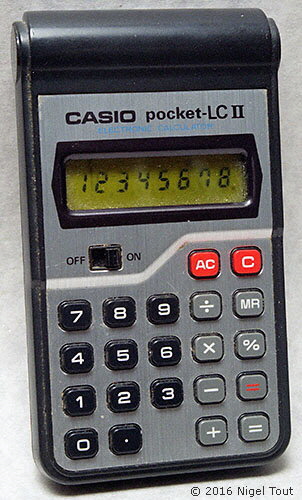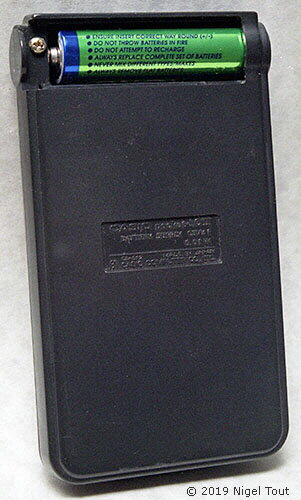Casio pocket-LC & pocket-LC II
Previously a small number of calculator models with Liquid Crystal Displays (LCDs) were marketed, but these used Dynamic Scattering Mode (DSM) liquid crystals. In these displays a tiny current through the transparent liquid crystal makes it change to a form which disperses light and looks white or silvery. Examples of calculators with this type of display are the Lloyds Accumatic 100 and the Sharp EL-805.
The earlier DSM LCDs have two disadvantages: firstly, the visibility of the digits depends on the lighting conditions and, secondly, although they use much less current that LED and VFD displays the current consumption is not negligible. These disadvantages were overcome with the next development in LCDs, the Twisted Nematic (TN) LCD. This type produce black digits on a grey background and are field-effect devices so the current used is negligible. Note that early TN LCDs have black numerals against a yellow background due to the use of a yellow filter over the display to absorb short wavelength rays in the ambient light that might degrade the liquid crystal.
Casio Computer Co. Ltd., was very innovative in calculator development and introduced the first hand-held calculator with a Twisted Nematic LCD display, the Casio pocket-LC here, introduced in 1975. This was followed by the Casio pocket-LC II.

Note that the display here is faulty and is not displaying any numerals.
Casio pocket-LC (aka cl-811)
Distinctive features: The first hand-held calculator with a liquid crystal display (LCD) using a TN (Twisted Nematic) LCD.
Technical details:
Display is 8 digits, TN LCD with yellow filter.
4-function, %, memory.
3v (2x button cells).
63 mm x 110 mm x 13 mm (2.5" x 4.3" x 0.5").
1975.
Made in Japan.
Note that the LCD in this example is faulty and does not display numerals.

Casio pocket-LC II
Distinctive features: The second hand-held calculator with a liquid crystal display (LCD) using a TN (Twisted Nematic) LCD.
Technical details:
Display is 8 digits, TN LCD with yellow filter.
4-function, %.
1.5v (AA battery, with a claimed operating life of 250 hours).
63 mm x 110 mm x 17 mm (2.5" x 4.3" x 0.7").
1976.
Made in Japan.
This, the second model in the Casio pocket LC range, changed from using two button cells to using a single AA cell. This gave a much longer battery life with only a very small increase in size.

The rear of the Casio pocket-LC II showing the single AA cell in a bulge at the top of the calculator.

Advertising brochure for the Casio pocket-LC II, with the claimed operating life of 250 hours.
When liquid crystal displays were first introduced in calculators in the early to mid-1970s there was a lot of discussion about the stability of the early liquid crystal material. This may be justified since from observation pocket-LC models have been seen with defective displays. Storage away from high temperatures is recommended to minimise ageing.
The Twisted Nematic (TN) LCD slowly became the dominant display technology for calculators through the second half of the 1970s, mainly due to the very low power consumption promoting very long battery life. Hand-held calculators with light emitting displays, such as LED and VFD, lost out due to large power consumption leading to short battery life, though this was less of a disadvantage in desktop AC-powered calculators where a slightly increased power consumption was less of a problem.
Hand-held Calculators
Vintage Calculators
Text & photographs copyright, except where stated otherwise, © Nigel Tout 2000-2026.